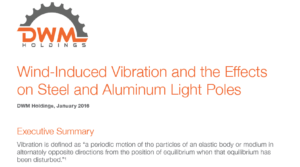 Wind-Induced Vibration and the Effects on Steel and Aluminum Light Poles provides detailed information about what Aeolian vibration is, how it can be identified, how wind-induced vibration can affect the performance and strength of light poles, and ways the effects of vibration can be mitigated both pro- and retroactively.
Wind-Induced Vibration and the Effects on Steel and Aluminum Light Poles provides detailed information about what Aeolian vibration is, how it can be identified, how wind-induced vibration can affect the performance and strength of light poles, and ways the effects of vibration can be mitigated both pro- and retroactively.
Early in the pole selection process, considerations for aesthetic requirements (color, height, and shape), environmental factors (wind zones, location, and field conditions), and load restrictions (fixture, brackets, and total EPA) are made. At this point, it is important to adhere to the guidelines set forth by the American Association of State Highway and Transportation Officials (AASHTO). AASHTO has provided the 1994 Fastest Mile Wind Map and the 2001/2009/2013 3-Second Gust Wind Map. The standards and codes have been created from historical analysis and research.
The wind maps take the following factors into account:
 Adhering to the AASHTO wind maps, guidelines and standards as well as any local building codes should accurately allow for consideration of First Mode Vibration during the pole selection process. First Mode Vibration is caused by sudden high-velocity gusts of wind, in which the maximum deflection occurs at the top of the pole. This can be viewed by the swaying of the pole. The effects of First Mode Vibration are usually not harmful to the pole of the luminaire. These types of winds are mapped by AASHTO.
Adhering to the AASHTO wind maps, guidelines and standards as well as any local building codes should accurately allow for consideration of First Mode Vibration during the pole selection process. First Mode Vibration is caused by sudden high-velocity gusts of wind, in which the maximum deflection occurs at the top of the pole. This can be viewed by the swaying of the pole. The effects of First Mode Vibration are usually not harmful to the pole of the luminaire. These types of winds are mapped by AASHTO.
The phenomenon know as Aeolian (or Second Mode) Vibration is caused by low-velocity, steady winds, normally ranging from 5-35mph and giving rise to frequencies of 2-20hz. This vibration is believed to be predominantly caused by air vortexing around the structure. As this steady stream of air passes across the pole, vortices are formed on the backside of the structure. The vortices alternate from the top and bottom surfaces and create alternating pressures that tend to produce movement at right angles to the direction of the air flow. This vortexing causes a high-frequency, short-cycle harmonic reaction in the structure — creating extreme stresses. This phenomenon is site specific and is, unfortunately, not predictable. Aeolian Vibration can be altered by as little as the shape of the structure, changing the fixture style or location, or having an object such as a tree or building alter the wind pattern.
United Lighting Standards has been committed to designing, fabricating, finishing, and packaging high-quality steel and aluminum poles since 1971. We adhere to standards set forth by AASHTO, ASTM International, and NEMA. All of our products are built using fabricating and welding procedures outlined in the American Welding Society (AWS) manual for steel and aluminum to eliminate welding defects and ensure structural integrity.
Read more about ULS